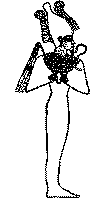Ancient Egyptians and the Constellations: Part 6
The Osiris Legend and the Tree of Life (the Axis Munde)
The earliest reference to the concept of the Tree of Life is to be found in the philosophy of the Ancient Egyptians. In the Osiris Legend, Osiris was induced by his wicked brother Set to lie down in a magnificent coffer under the pretext of a game at a banquet. Set and his seventy-two conspirators immediately closed the lid and threw the coffer into the Nile.
Osiris' wife Isis, who was also his sister, searched for and found the chest which had been borne down the Nile and across the sea to what was later identified as the Phoenician coast, where it was deposited at the foot of a tamarisk tree. As the tree grew it enclosed Osiris and the chest within its trunk ... which was later cut down by the king of Byblos and used as a pillar in his palace. The fragrance of the pillar became renowned far and wide, and when Isis heard about it she immediately understood its significance. Isis returned the pillar, and the body it contained, to Egypt.
In "Ancient Egyptians and the Constellations: Part 2" the Lost Secret of the process of the Creation of the Universe was disclosed … the Celestial Sphinx Hu / Osiris, symbolizing the Masculine Creation Principle, breathed Life into the constellations.
The loss of this Secret inspired another explanation of the Creation of the Universe. There was a primordial ocean called Nun. It wasn't flat; rather it was in the shape of a cosmic egg … and from this cosmic egg was born the primeval hill called Nu.
Both the egg and the primeval hill are recorded on pictures of Isis in the tombs of the Ancient Egyptian Pharaohs; indicating that Isis was the personification of the Feminine Creation Principle. She was the Holy Mother who was represented with her child Horus by the Constellation of Virgo. Isis was considered Virgin as she was seeded after the death and resurrection of Osiris … minus the phallus.

Isis,
the Feminine
Creation Principle

Constellation of
Virgo represented
Isis, the Holy Mother

Constellation of
Virgo flipped
180 degrees

Isis, the
Holy Mother
In ancient Egyptian texts it is written of the Tree of Life, "I am the plant which comes from Nu." The Tree of Life grew out of the Sacred Mound, it's branches reaching out and supporting the star and planet studded sky, while it's roots reached down into the watery abyss of the Netherworld. The trunk of the Tree of Life represented the World Pillar or Axis Munde (literally "Axis of the Mound") around which the heavens appeared to revolve. The World Pillar was the centre of the universe.
The Ancient Egyptian symbol for "plant" meaning "Tree of Life" was three sacred lotus lilies. They have tree stems curving to the left as though blown into Life by the breath of Hu, the Celestial Sphinx. On top of each stem is the Lotus flower which was used in Ancient Egypt to represent Life and Resurrection. It is from this hieroglyph that the "fleur de lis" which is frequently found in Ancient Egyptian Art traces its origin. The "fleur de lis" represents the Tree of Life. The glyph which denotes the sacred knowledge associated with Hu is also formed by the three stems of the three sacred lotus lilies. The Osiris Crown can be similarly considered in these terms. Following the role model of Osiris, in 1346AD Edward the Black Prince won three feathers at Crecy which he adopted as his emblem. If the three feathers are gathered at the stems a fleur de lis is created.












